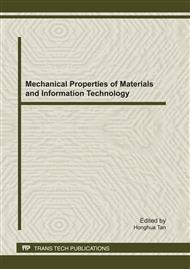[1]
Carskadon MA, Dement WC. Mitler MM, Roth T, Westbrook PR, Keenan S. Guidelines for the Multiple Sleep Latency Test (MSLT): A Standard Measure of Sleepiness. Sleep, 1986, 9(4), pp.519-524.
DOI: 10.1093/sleep/9.4.519
Google Scholar
[2]
Cole RJ, Kripke DF, Gruen W, Mullaney DJ, Gillin JC. Automatic Sleep/Wake Identification From Wrist Activity. Sleep, 1992, 15(5), pp.461-469.
DOI: 10.1093/sleep/15.5.461
Google Scholar
[3]
Dement W, Kleitman N. Cyclic variations in EEG during sleep and their relation to eye movements, body motility, and dreaming. Electroencephalogr Clin Neurophysiol 1957, 9(4), p.673–90.
DOI: 10.1016/0013-4694(57)90088-3
Google Scholar
[4]
Aserinsky E, Kleitman N. Two Types of Ocular Motility Occurring in Sleep. Journal of applied physiology, 1955, 8(1), pp.1-10.
DOI: 10.1152/jappl.1955.8.1.1
Google Scholar
[5]
Kenneth P, Wright Jr, Joseph HT, Charles CA. Relationship Between Alertness, Performance, and Body Temperature in Humans. American Journal of Physiology, 2002, 283(6), pp.1370-1377.
Google Scholar
[6]
Cajochen C, Khalsa SBS, Wyatt JK, Czeisler CA, Dijk DJ. EEG and Ocular Correlates of Circadian Melatonin Phase and Human Performance Decrements During Sleep Loss. American Journal of Physiology, 1999, 277, p.640–649.
DOI: 10.1152/ajpregu.1999.277.3.r640
Google Scholar
[7]
Ji Qiang and Yang Xiaojie. Real-Time Eye, Gaze, and Face Pose Tracking for Monitoring Driver Vigilance. Real-Time Imaging, 2002, 8, pp.357-377.
DOI: 10.1006/rtim.2002.0279
Google Scholar
[8]
Parasuraman. Memoryload event rate control sensitivity decrements in sustained attention. Science, 1979, 205, p.924–927.
DOI: 10.1126/science.472714
Google Scholar
[9]
Peiris MTR, Jones RD, Davidson PR, Carroll GJ, Signal TL, Parkin PJ, van den Berg M, Bones PJ. Identification of Vigilance Lapses using EEG/EOG by Expert Human Raters. In Proceedings of the 2005 IEEE Engineering in Medicine and Biology 27th Annual Conference Shanghai, China, September 1-4, (2005).
DOI: 10.1109/iembs.2005.1615790
Google Scholar
[10]
Makeig S. Using Feedforward Neural Networks to Monitor Alertness from Changes in EEG Correlation and Coherence. Advances in Neural Information Processing Systems, 1996, 8, pp.931-937.
Google Scholar
[11]
Vuckovic A, Radivojevic V, Chen ACN, Popover D. Automatic Recognition of Alertness and Drowsiness from EEG by an Artificial Neural Network. Medical Engineering & Physics, 2002, 24(5), pp.349-360.
DOI: 10.1016/s1350-4533(02)00030-9
Google Scholar
[12]
Tononi G, McIntosh AR, Patrick Russell D, Gerald Edelman M, Functional Clustering: Identifying Strongly Interactive Brain Regions in Neuroimaging Data, 1998, Neuroimage, 7, pp.133-149.
DOI: 10.1006/nimg.1997.0313
Google Scholar
[13]
Xiaobin Li, Derong Jiang, Study on the Application of COM Method in Motor Imagine. Advanced Material Research, 2011(187), 762-766.
DOI: 10.4028/www.scientific.net/amr.187.762
Google Scholar
[14]
Derong Jiang, Jianfeng Hu. Research of Drowsiness in Driving Based on EEG. 3rd International Symposium on Electronic Commerce and Security (ISECS 2010), 2010(2), pp.639-642.
DOI: 10.1109/isecs.2010.79
Google Scholar
[15]
DerongJiang, Jinghai Yin. A Realtime Brain-Computer Interface Based on PDA. ICIMA 2010, 2010(1), 188–192.
Google Scholar
[16]
Derong Jiang, Jianfeng Hu. Research of key technology in game theory, 010 2nd Conference on Environmental Science and Information Application Technology (ESIAT 2010), 2010(2), pp.639-642.
DOI: 10.1109/esiat.2010.5568293
Google Scholar
[17]
Derong Jiang, Jianfeng Hu. Research of Welch arithmetic and wavelet transforms for person identification of EEG. Computer Science and Engineering (WCSE 2009), 2009(2), pp.449-452.
DOI: 10.1109/wcse.2009.850
Google Scholar


